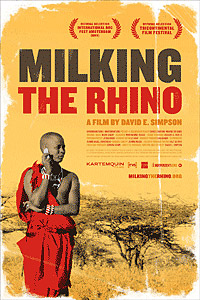| Milking the Rhino | |
|---|---|
 | |
| Directed by | David E. Simpson |
| Produced by | David E. Simpson Gordon Quinn Jeannie R. Magill (co-producer) |
| Cinematography | Jason Longo |
| Edited by | David E. Simpson |
| Music by | Joel Diamond |
| Distributed by | Kartemquin Films |
Release date |
|
Running time | 83 minutes |
| Country | United States |
| Languages | English Maasai Swahili Ojihimba |
Milking the Rhino is a 2009 documentary film, produced by Kartemquin Films, that examines the relationship between the indigenous African wildlife, the villagers who live amongst this wildlife, and conservationists who look to keep tourism dollars coming in. Both the Maasai of Kenya and the Ovahimba of Namibia have spent centuries as cattle farmers. With their land being turned into protected game reserves, these ancient tribes have turned to tourism as a means of survival. [1]
Contents
While some environmentalists think that community-based conservation is ideal for these villagers, the dangers of drought and the starvation of their cattle remain a constant reality. Stuck between the always-growing Western influence that wants Africa to remain a place for sightseeing safaris and their own ancient cultures, the Maasai and Himba are at a crossroads of cultural change. [2]
The Kenyan section of the movie features interviews with Kinanjui Lesenderia, an Ndorobo Maasai elder at Il Ngwesi in Kenya, Ian Craig, former rancher and founder of the Lewa Wildlife Conservancy, James Ole Kinyaga, Senior Host of Kenya's first community-owned and managed eco-lodge, and Helen Gichohi, President of the African Wildlife Foundation. [3]